Frantzou
Hatching
- Feb 24, 2015
- 1
- 0
- 8
What i
This way individuals do not have to search through the posts to find answers to their questions.
Introduction
The number 1 rule is that two sex linked chickens can not be crossed to produce sex linked offspring. A sex linked chicken can not be crossed with any other variety of chicken to produce sex linked offspring. A person can not produce sex linked offspring if they cross a male sex linked variety with any variety of female. A person can not produce sex linked offspring if they cross any variety of male with a sex linked female. A person can not use sex linked birds in any cross to produce sex linked offspring. There is one exception to rule number one; a red sex link that is a non-barred and non-dominant white male can be used in a black sex linked cross.
The second important rule is that one should not use white birds in sex linked crosses. White birds that have the correct genotype can be used to make a sex linked cross but a breeder never knows if the white bird has the correct genotype. The authors advise concerning white birds and sex linked crossing is do not use white birds in sex linked crosses. White leghorns can not be used in any kind of color sex linked cross.
There are 3 common methods that are used to sex day old chicks and two of the ways involve sex linked traits. There are color sexing, feather sexing and vent sexing. Vent sexing is exactly what it sounds like. Before the vent is opened, the feces in the chick must be expelled by gently squeezing the abdomen. The chicks vent is then opened and examined to determine if the chick is a male or a female. The copulatory organ (penis) of the male is a different shape and much larger than that of the females clitoris. The problem with vent sexing is that there are over fifteen different shapes associated with the copulatory organs and most people do not want to look into the cloaca or vent of a chick.
This post will first discuss color sexing, red sex-linked then black sex linked. Following this will be a discussion dealing with feather sexing.
Color sexing is a tried and true way of sexing day old chicks. There are two basic kinds of sex linked color crosses; there are the red sex-linked cross and the black sex-linked cross. Any breeder can produce red sex linked chicks if they have a red male and silver female chicken that carry the correct genotype (genes a bird carries). The red male parent in the cross must carry two sex linked gold alleles (s+/s+) while the silver female must carry the silver allele (S/_w).
The most important thing to remember about sex-linked crosses is that 1) female offspring inherit their sex-linked trait from the father and 2) the male offspring inherit a sex-linked trait from the mother and a sex-linked trait from the father.
Red Sex Linked Crosses
If the sex-linked trait is dominant in the mother and recessive in the father (the father carries two recessive alleles) then the sons will express the dominant trait inherited from the mother, while the daughters will express the recessive trait inherited from the father. This is the key to sex linked crosses; the male offspring can be separated from the female offspring when they hatch from the egg.
An example of this is the inheritance of the silver and gold alleles (genes) that are used in a red sex linked cross. In this case, the father has two recessive gold alleles (s+/s+) and the mother has one dominant silver allele (S). An example of a gold bird is a rhode island red and an example of a silver bird is a delaware.
A gold male Silver female


When the cross is made, the male offspring will inherit a gold allele (s+) from the father and a silver allele (S) from the mother. The males will inherit two different alleles, one silver and one gold; silver is dominant therefore the male chicks will have white down due to the dominant silver gene.
The mother can only give her silver allele to her sons; the mother does not determine the down color of the daughters. Only the father determines the down color of the daughters. The father will give one gold allele to each daughter causing the down of the daughters to be reddish in color.
The diagram below illustrates how offspring inherit alleles.

The down color of red sex linked chicks can vary depending on the breed of bird used to make the red sex linked cross. Different breeds of chickens carry different kinds of genes and it is the genes that cause the different colors in the chick down.
The chick on the right is the perfect example of the red down color and the chick on the left is the perfect example of silver or white down color. As can be seen, the female (red) is easily distinguished from the male (silver or white).
Illustration1

Not all sex linked crosses will produce the perfect down color. Here is another example of the down color associated with a sex linked cross. The gold female is on top and the silver male is on the bottom of the picture.
Illustration 2

Some crosses using silver females and gold males produce offspring that can not easily be separated into groups of male chicks or female chicks. It is important that the breeder choose the correct breeds to use in making a red sex linked cross.
As a general rule, do not use autosomal barred birds ( Campine, Fayoumi, etc) or spangled birds ( Appenzeller, Hamburg, etc.) and laced Polish ( laced tail and single lacing). These birds carry the birchen allele which will not produce the down colors needed in a red sex linked cross.
The author carried out a red sex-linked cross between a silver Appenzeller Spitzhauben female and a Rhode Island Red male. The only way you could tell the difference between the male and female chicks was by a small amount of reddish or whitish color on the chin. On some chicks, you could not distinguish the difference between the gold and white on the chin. See Illustration 3 The back of the chick in illustration 3 is black; the black down is covering the reddish or white down making it impossible to determine the sex of the chick.
Illustration 3

Breeds to Cross

The above table provides some of the more common standard size breeds and varieties that can be used to produce red sex linked offspring. The table does not include every possible silver or gold variety that can be used to produce sex linked crosses. It is not a good idea to cross just any gold male with a silver female. Research shows that specific combinations of genes are more effective at producing red sex linked chicks from gold male and silver female matings. The information concerning down color that follows this paragraph was compiled from published research. If you have had different results, it would be due to your birds being genetically different than the birds used in the research.
Additional male birds that can be used in a red-sex linked cross: Blue Laced Red Wyandotte, Wheaten or Blue Wheaten or Buff Ameraucana, Black Breasted Red or Buff Araucana, Buckeye, Buttercup, White Laced Red or Red or Buff Cornish, Black Breasted Red Cubalaya, Golden Lakenvelder, and Buff Minorca.
1 To insure the most effective color sexing, a person would cross any Group 1 male with the Salmon Faverolle, columbian leghorn, light sussex found in female Group 1. This cross will produce wheaten and columbian restricted chicks which according to many researchers is the preeminent genotype that expresses gold and silver. Silver males do not always have clear down and may express back and head markings.
Crossing a Group 1 male with a Rhode Island White will produce females that have reddish down while males will have a whitish down. The Rhode island white is the only bird in the table that normally carries dominant white. Other white birds may or may not carry dominant white.
The first five males in Group 1 should contain mahogany (Mh) which heightens the buff color in a gold chick making the classification of gold chicks and silver chicks much more effective. The authors personal favorite from the Group 1 males would be the Rhode Island Red.
(1) Buff birds may be used in sex linked crosses but the light gold down expression by female chicks is more difficult to classify. Buff birds may also contain mahogany but in buff birds the mahogany does not heighten the expression of gold in the down.
2. Crossing a Group 1 male with any Group 2A or 2B female produces the effective expression of gold or silver in the offspring. This cross produces chicks with a pseudo-wild type down with gold or silver expression in the non-striped areas of the down. See Illustration 2
* White Wyandottes and *White Plymouth Rocks are not a good choice. They sometimes have the correct genotype to produce sex linked chicks and at other times, they do not have the correct genotype to produce sex linked chicks. If a White Wyandotte carries the correct genotype, then the male down will vary in color: whitish, yellowish or even smoky white. The females produced from a Rhode Island Red and White Wyandotte cross can also vary in color from a striped gold down into a light buff color.
3. Group 1 males can be crossed with Group 3 females. This cross produces the pseudo-wild type down with gold or silver being expressed on the back and face. See Illustration 2.
4. Group 2A males may be crossed with two Group 1 females; the Light Sussex and the Salmon faverolle. This cross produces chicks with a pseudo--wild type down with gold or silver being expressed in the non-striped areas of the down (see Illustration 2).
Crossing a Group 2 male with a Rhode Island White will produce females that have reddish down while males will have whitish down.
Similar to Illustration 1.
5. The following crosses produce a black back phenotype (See Illustration 3) with the gold or silver being expressed on the face and fore head of the chick.
Cross a Group 2 A male with a Group 2 A or 2B female.
Cross a Group 2 B male with a 2A female.
If dominant white is introduced into this cross, the black back is removed and the chicks will look more like Illustration 1.
6. Group 3 Males may be crossed with the Group 1 salmon faverolle female which produces the pseudo-wild type down with gold or silver being expressed on the back and face.
Group 3 males crossed with a Group 1 Rhode Island White produces yellowish white males and females that are yellowish white with a gold head and back.
Group 3 males crossed with 2A females produce a black back phenotype; females will have a gold face and males will have a silver face.
7. Group 3 crossed with Group 3 females produces males with a silver gray ground color and females with a gold to tan ground color.
Black Sex-linked
There are two important genes that must be a part of a black sex-linked cross; the E locus allele called extended black (E) and the sex-linked barring gene (B). The Barred Plymouth rock carries both E and B and both genes are used as the female side in commercial black sex linked crosses while the male side of the cross is a Rhode Island Red or a New Hampshire. Birchen birds at times can be used in black sex linked crosses. It is best to leave the use of birchen birds to individuals that have tested the birds for the correct genotype. If birchen birds do not have the correct genotype, the offspring will not be black sex linked.
A few specifics to remember about a black sex-linked cross are:
1) the female must carry sex-linked barring (barred),
2) the male can not carry sex-linked barring (male can not be barred),
3) one of the birds must be homozygous for extended black or carry two extended black genes and
4) neither of the birds can carry dominant white or in other words be a white bird. Some recessive white birds may work on the male side of the cross but you never know if it will work or not work. So I suggest not using white birds.
5). Almost any variety (color) of male ( not including white or barred ) can be used in a black sex linked cross. White birds sometimes carry dominant white and or barring which would not work in a black sex linked cross. White males that do not carry dominant white or barring will work as the male in a black sex linked cross. White males like the white wyandotte or the white plymouth rock will work if they do not carry dominant white or barring.
In a black sex-linked cross, the female will only contribute the barring gene to the male offspring. So the adult males will be black and barred. The female offspring will receive their sex linked trait from the father; in this case, the recessive gene for no barring. So the females will not be barred as adults.
It is also important that the chick down has a black dorsal surface, back and top of the head; this allows for the barring gene to be expressed as a white or cream spot on top of the male chicks head. See Illustration 5. This is why a white bird that carries dominant white can not be used to produce black sex linked chicks. The top of the head would be white and the white spot will not show. Males that carry barring can not be used because the males will produce females chicks with white spots on their heads.
The top of a female chicks head will be a solid black color. See Illustration 6. The chicks in the pictures do not have a white belly like many other black sex linked chicks.
Illustration 5 male black sex-link Illustration 6 female black sex-link


Examples of breeds that can be used for black sex linked crosses.

1 Male carries the blue egg shell gene.
2 Not a good choice may carry barring.
3. Carry the genes for white egg shell.
Feather Sexing Chicks
Color sexing chicks can be a difficult task and is dependent upon the phenotype of the chick. If a chick does not have the correct down color, then you can not color sex the chick. There is a way of using another sex-linked trait to sex chicks based upon the size of the primary and secondary feathers on the wing of a newly hatched chick.
Feather sexing chicks can be accomplished by crossing males that are homozygous for rapid feather growth or carry two rapid feather growth alleles ( k+/k+) with females that are hemizygous or carry only one slow feather growth allele ( K/_W).
The female parent contributes a dominant gene for slow feather growth (K) to all the male offspring while the female offspring will inherit only one rapid feather growth allele ( k+) from the father. This cross produces males that have slow feather growth (K/k+) and females that have rapid feather growth (k+/_W).
The following site provides an excellent example of how to tell the difference between a rapid feathering female (pullet) chick and a slow feathering male (cockerel) chick. You have to examine the feathers on the wings of the newly hatched chick. Wait until the down dries and examine the wing feathers.
http://animalsciences.missouri.edu/reprod/ReproTech/Feathersex/sld006.htm
The table below contains some of the birds that can be crossed to produce chicks that can be feather sexed.
Any of the males in the table, can be crossed with any of the females in the table to produce offspring that can be feather sexed. If you purchased your birds from a hatchery, check with the hatchery to see if the hatchery feather sexed the birds you purchased. If your stock was feather sexed, then the chickens can not be used for feather sexing crosses.

Questions and Answers
Q 1. Can a gold laced or blue laced red wyandotte rooster be crossed with a silver laced wyandotte female and produce red sex linked chicks?
A. 1. Yes, the chicks with buff on their faces are females and the chicks with white in their faces will be males. Both males and females will also have black patterns on their head and face which will hide some of the buff or white facial down. Silver laced wyandotte females should be included in group 2B in the Breeds to Cross table.
_________________________________________________________________________________________________________________________
Q 2 What happens if you cross a black sex-linked hen with a Rhode Island Red rooster?
A. This will not produce sex linked chicks. Black sex linked hens can not be used in any kind of sex linked cross involving color.
_________________________________________________________________________________________________________________________
Q 3 Can I use any kind of sex linked hen or sex linked rooster ( black sex linked or red sex linked) to produce sex linked chicks?
A. The best answer is no but there is an exception a non-barred and non-dominant white red sex linked male can be used in a black sex linked cross.
_________________________________________________________________________________________________________________________
Q 4 Can a light sussex be used as the female in a red sex linked cross?
A. Yes , Light sussex are wheaten, silver and columbian restricted which will work well. The light sussex should be included in group 1 in the Breeds to Cross table.
_________________________________________________________________________________________________________________________
Q 5 Would it better to produce a red sex-link, if I used a New Hampshire Red Rooster or a Rhode island red Rooster ; with light sussex hens?
A. Both the New Hampshire and Rhode Island Red on a light sussex hen are a very good red sex linked cross. The offspring will be reddish females and whitish males.
__________________________________________________________________________________________________________________________________
Q 6 What color or colors of chickens are produced by crossing a red sex linked male ( like a golden comet) with red sex linked female (like a golden comet)?
A. The offspring will be like Rhode Island Red or like a red sex linked (white tailed red/like a golden comet), or solid white or columbian ( light sussex) with some red on their backs.
___________________________________________________________________________________________________________________________________
Q 7 Are there other varieties of males, not in the table, that can be used to make black sex linked crosses?
A. Yes In making a black sex linked cross, almost any variety of male ( white or barred should not be used) can be crossed with a purebred barred hen to produce black sex linked chicks. The barred female must come from the black sex linked table or have the correct genotype.
____________________________________________________________________________________________________________________________________
I hope this helps breeders with color sexing and feather sexing chicks.
[/quote
If you read this and have questions, please send me a Personal Message and I will create a question and answer section in this post.
This way individuals do not have to search through the posts to find answers to their questions.
Introduction
The number 1 rule is that two sex linked chickens can not be crossed to produce sex linked offspring. A sex linked chicken can not be crossed with any other variety of chicken to produce sex linked offspring. A person can not produce sex linked offspring if they cross a male sex linked variety with any variety of female. A person can not produce sex linked offspring if they cross any variety of male with a sex linked female. A person can not use sex linked birds in any cross to produce sex linked offspring. There is one exception to rule number one; a red sex link that is a non-barred and non-dominant white male can be used in a black sex linked cross.
The second important rule is that one should not use white birds in sex linked crosses. White birds that have the correct genotype can be used to make a sex linked cross but a breeder never knows if the white bird has the correct genotype. The authors advise concerning white birds and sex linked crossing is do not use white birds in sex linked crosses. White leghorns can not be used in any kind of color sex linked cross.
There are 3 common methods that are used to sex day old chicks and two of the ways involve sex linked traits. There are color sexing, feather sexing and vent sexing. Vent sexing is exactly what it sounds like. Before the vent is opened, the feces in the chick must be expelled by gently squeezing the abdomen. The chicks vent is then opened and examined to determine if the chick is a male or a female. The copulatory organ (penis) of the male is a different shape and much larger than that of the females clitoris. The problem with vent sexing is that there are over fifteen different shapes associated with the copulatory organs and most people do not want to look into the cloaca or vent of a chick.
This post will first discuss color sexing, red sex-linked then black sex linked. Following this will be a discussion dealing with feather sexing.
Color sexing is a tried and true way of sexing day old chicks. There are two basic kinds of sex linked color crosses; there are the red sex-linked cross and the black sex-linked cross. Any breeder can produce red sex linked chicks if they have a red male and silver female chicken that carry the correct genotype (genes a bird carries). The red male parent in the cross must carry two sex linked gold alleles (s+/s+) while the silver female must carry the silver allele (S/_w).
The most important thing to remember about sex-linked crosses is that 1) female offspring inherit their sex-linked trait from the father and 2) the male offspring inherit a sex-linked trait from the mother and a sex-linked trait from the father.
Red Sex Linked Crosses
If the sex-linked trait is dominant in the mother and recessive in the father (the father carries two recessive alleles) then the sons will express the dominant trait inherited from the mother, while the daughters will express the recessive trait inherited from the father. This is the key to sex linked crosses; the male offspring can be separated from the female offspring when they hatch from the egg.
An example of this is the inheritance of the silver and gold alleles (genes) that are used in a red sex linked cross. In this case, the father has two recessive gold alleles (s+/s+) and the mother has one dominant silver allele (S). An example of a gold bird is a rhode island red and an example of a silver bird is a delaware.
A gold male Silver female

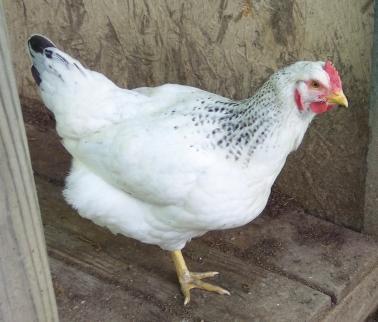
When the cross is made, the male offspring will inherit a gold allele (s+) from the father and a silver allele (S) from the mother. The males will inherit two different alleles, one silver and one gold; silver is dominant therefore the male chicks will have white down due to the dominant silver gene.
The mother can only give her silver allele to her sons; the mother does not determine the down color of the daughters. Only the father determines the down color of the daughters. The father will give one gold allele to each daughter causing the down of the daughters to be reddish in color.
The diagram below illustrates how offspring inherit alleles.
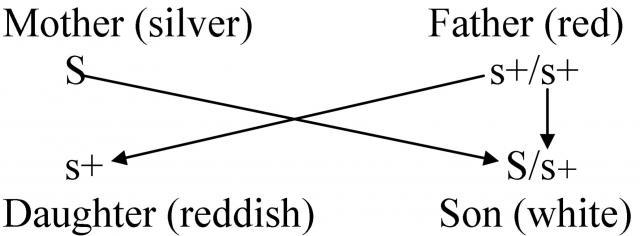
The down color of red sex linked chicks can vary depending on the breed of bird used to make the red sex linked cross. Different breeds of chickens carry different kinds of genes and it is the genes that cause the different colors in the chick down.
The chick on the right is the perfect example of the red down color and the chick on the left is the perfect example of silver or white down color. As can be seen, the female (red) is easily distinguished from the male (silver or white).
Illustration1
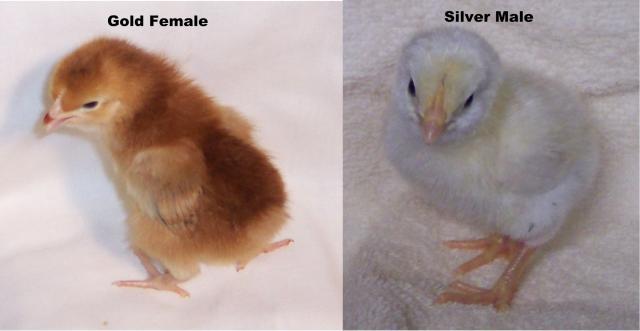
Not all sex linked crosses will produce the perfect down color. Here is another example of the down color associated with a sex linked cross. The gold female is on top and the silver male is on the bottom of the picture.
Illustration 2
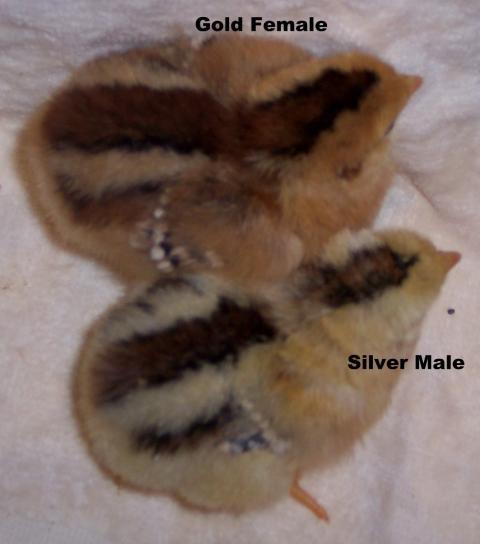
Some crosses using silver females and gold males produce offspring that can not easily be separated into groups of male chicks or female chicks. It is important that the breeder choose the correct breeds to use in making a red sex linked cross.
As a general rule, do not use autosomal barred birds ( Campine, Fayoumi, etc) or spangled birds ( Appenzeller, Hamburg, etc.) and laced Polish ( laced tail and single lacing). These birds carry the birchen allele which will not produce the down colors needed in a red sex linked cross.
The author carried out a red sex-linked cross between a silver Appenzeller Spitzhauben female and a Rhode Island Red male. The only way you could tell the difference between the male and female chicks was by a small amount of reddish or whitish color on the chin. On some chicks, you could not distinguish the difference between the gold and white on the chin. See Illustration 3 The back of the chick in illustration 3 is black; the black down is covering the reddish or white down making it impossible to determine the sex of the chick.
Illustration 3
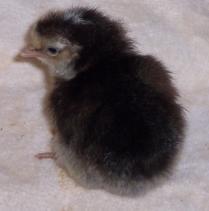
Breeds to Cross
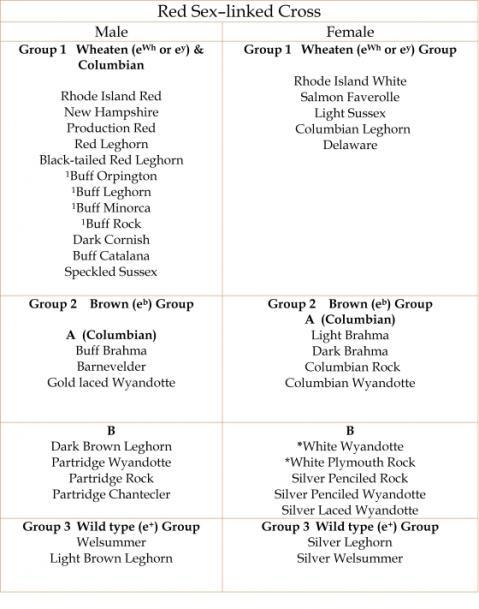
The above table provides some of the more common standard size breeds and varieties that can be used to produce red sex linked offspring. The table does not include every possible silver or gold variety that can be used to produce sex linked crosses. It is not a good idea to cross just any gold male with a silver female. Research shows that specific combinations of genes are more effective at producing red sex linked chicks from gold male and silver female matings. The information concerning down color that follows this paragraph was compiled from published research. If you have had different results, it would be due to your birds being genetically different than the birds used in the research.
Additional male birds that can be used in a red-sex linked cross: Blue Laced Red Wyandotte, Wheaten or Blue Wheaten or Buff Ameraucana, Black Breasted Red or Buff Araucana, Buckeye, Buttercup, White Laced Red or Red or Buff Cornish, Black Breasted Red Cubalaya, Golden Lakenvelder, and Buff Minorca.
1 To insure the most effective color sexing, a person would cross any Group 1 male with the Salmon Faverolle, columbian leghorn, light sussex found in female Group 1. This cross will produce wheaten and columbian restricted chicks which according to many researchers is the preeminent genotype that expresses gold and silver. Silver males do not always have clear down and may express back and head markings.
Crossing a Group 1 male with a Rhode Island White will produce females that have reddish down while males will have a whitish down. The Rhode island white is the only bird in the table that normally carries dominant white. Other white birds may or may not carry dominant white.
The first five males in Group 1 should contain mahogany (Mh) which heightens the buff color in a gold chick making the classification of gold chicks and silver chicks much more effective. The authors personal favorite from the Group 1 males would be the Rhode Island Red.
(1) Buff birds may be used in sex linked crosses but the light gold down expression by female chicks is more difficult to classify. Buff birds may also contain mahogany but in buff birds the mahogany does not heighten the expression of gold in the down.
2. Crossing a Group 1 male with any Group 2A or 2B female produces the effective expression of gold or silver in the offspring. This cross produces chicks with a pseudo-wild type down with gold or silver expression in the non-striped areas of the down. See Illustration 2
* White Wyandottes and *White Plymouth Rocks are not a good choice. They sometimes have the correct genotype to produce sex linked chicks and at other times, they do not have the correct genotype to produce sex linked chicks. If a White Wyandotte carries the correct genotype, then the male down will vary in color: whitish, yellowish or even smoky white. The females produced from a Rhode Island Red and White Wyandotte cross can also vary in color from a striped gold down into a light buff color.
3. Group 1 males can be crossed with Group 3 females. This cross produces the pseudo-wild type down with gold or silver being expressed on the back and face. See Illustration 2.
4. Group 2A males may be crossed with two Group 1 females; the Light Sussex and the Salmon faverolle. This cross produces chicks with a pseudo--wild type down with gold or silver being expressed in the non-striped areas of the down (see Illustration 2).
Crossing a Group 2 male with a Rhode Island White will produce females that have reddish down while males will have whitish down.
Similar to Illustration 1.
5. The following crosses produce a black back phenotype (See Illustration 3) with the gold or silver being expressed on the face and fore head of the chick.
Cross a Group 2 A male with a Group 2 A or 2B female.
Cross a Group 2 B male with a 2A female.
If dominant white is introduced into this cross, the black back is removed and the chicks will look more like Illustration 1.
6. Group 3 Males may be crossed with the Group 1 salmon faverolle female which produces the pseudo-wild type down with gold or silver being expressed on the back and face.
Group 3 males crossed with a Group 1 Rhode Island White produces yellowish white males and females that are yellowish white with a gold head and back.
Group 3 males crossed with 2A females produce a black back phenotype; females will have a gold face and males will have a silver face.
7. Group 3 crossed with Group 3 females produces males with a silver gray ground color and females with a gold to tan ground color.
Black Sex-linked
There are two important genes that must be a part of a black sex-linked cross; the E locus allele called extended black (E) and the sex-linked barring gene (B). The Barred Plymouth rock carries both E and B and both genes are used as the female side in commercial black sex linked crosses while the male side of the cross is a Rhode Island Red or a New Hampshire. Birchen birds at times can be used in black sex linked crosses. It is best to leave the use of birchen birds to individuals that have tested the birds for the correct genotype. If birchen birds do not have the correct genotype, the offspring will not be black sex linked.
A few specifics to remember about a black sex-linked cross are:
1) the female must carry sex-linked barring (barred),
2) the male can not carry sex-linked barring (male can not be barred),
3) one of the birds must be homozygous for extended black or carry two extended black genes and
4) neither of the birds can carry dominant white or in other words be a white bird. Some recessive white birds may work on the male side of the cross but you never know if it will work or not work. So I suggest not using white birds.
5). Almost any variety (color) of male ( not including white or barred ) can be used in a black sex linked cross. White birds sometimes carry dominant white and or barring which would not work in a black sex linked cross. White males that do not carry dominant white or barring will work as the male in a black sex linked cross. White males like the white wyandotte or the white plymouth rock will work if they do not carry dominant white or barring.
In a black sex-linked cross, the female will only contribute the barring gene to the male offspring. So the adult males will be black and barred. The female offspring will receive their sex linked trait from the father; in this case, the recessive gene for no barring. So the females will not be barred as adults.
It is also important that the chick down has a black dorsal surface, back and top of the head; this allows for the barring gene to be expressed as a white or cream spot on top of the male chicks head. See Illustration 5. This is why a white bird that carries dominant white can not be used to produce black sex linked chicks. The top of the head would be white and the white spot will not show. Males that carry barring can not be used because the males will produce females chicks with white spots on their heads.
The top of a female chicks head will be a solid black color. See Illustration 6. The chicks in the pictures do not have a white belly like many other black sex linked chicks.
Illustration 5 male black sex-link Illustration 6 female black sex-link
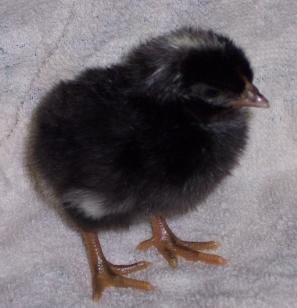
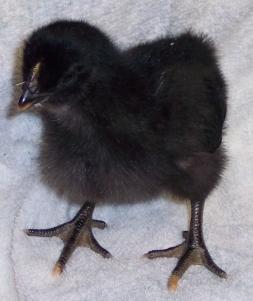
Examples of breeds that can be used for black sex linked crosses.
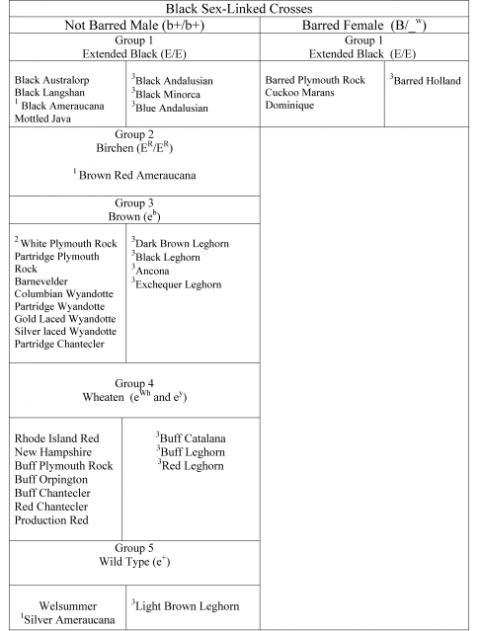
1 Male carries the blue egg shell gene.
2 Not a good choice may carry barring.
3. Carry the genes for white egg shell.
Feather Sexing Chicks
Color sexing chicks can be a difficult task and is dependent upon the phenotype of the chick. If a chick does not have the correct down color, then you can not color sex the chick. There is a way of using another sex-linked trait to sex chicks based upon the size of the primary and secondary feathers on the wing of a newly hatched chick.
Feather sexing chicks can be accomplished by crossing males that are homozygous for rapid feather growth or carry two rapid feather growth alleles ( k+/k+) with females that are hemizygous or carry only one slow feather growth allele ( K/_W).
The female parent contributes a dominant gene for slow feather growth (K) to all the male offspring while the female offspring will inherit only one rapid feather growth allele ( k+) from the father. This cross produces males that have slow feather growth (K/k+) and females that have rapid feather growth (k+/_W).
The following site provides an excellent example of how to tell the difference between a rapid feathering female (pullet) chick and a slow feathering male (cockerel) chick. You have to examine the feathers on the wings of the newly hatched chick. Wait until the down dries and examine the wing feathers.
http://animalsciences.missouri.edu/reprod/ReproTech/Feathersex/sld006.htm
The table below contains some of the birds that can be crossed to produce chicks that can be feather sexed.
Any of the males in the table, can be crossed with any of the females in the table to produce offspring that can be feather sexed. If you purchased your birds from a hatchery, check with the hatchery to see if the hatchery feather sexed the birds you purchased. If your stock was feather sexed, then the chickens can not be used for feather sexing crosses.
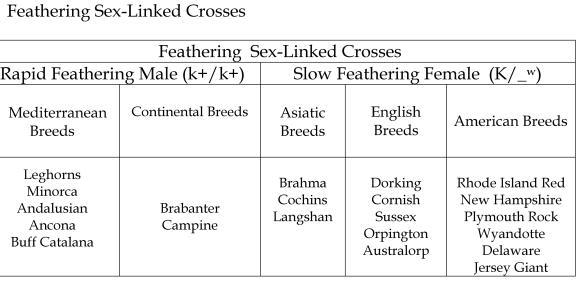
Questions and Answers
Q 1. Can a gold laced or blue laced red wyandotte rooster be crossed with a silver laced wyandotte female and produce red sex linked chicks?
A. 1. Yes, the chicks with buff on their faces are females and the chicks with white in their faces will be males. Both males and females will also have black patterns on their head and face which will hide some of the buff or white facial down. Silver laced wyandotte females should be included in group 2B in the Breeds to Cross table.
_________________________________________________________________________________________________________________________
Q 2 What happens if you cross a black sex-linked hen with a Rhode Island Red rooster?
A. This will not produce sex linked chicks. Black sex linked hens can not be used in any kind of sex linked cross involving color.
_________________________________________________________________________________________________________________________
Q 3 Can I use any kind of sex linked hen or sex linked rooster ( black sex linked or red sex linked) to produce sex linked chicks?
A. The best answer is no but there is an exception a non-barred and non-dominant white red sex linked male can be used in a black sex linked cross.
_________________________________________________________________________________________________________________________
Q 4 Can a light sussex be used as the female in a red sex linked cross?
A. Yes , Light sussex are wheaten, silver and columbian restricted which will work well. The light sussex should be included in group 1 in the Breeds to Cross table.
_________________________________________________________________________________________________________________________
Q 5 Would it better to produce a red sex-link, if I used a New Hampshire Red Rooster or a Rhode island red Rooster ; with light sussex hens?
A. Both the New Hampshire and Rhode Island Red on a light sussex hen are a very good red sex linked cross. The offspring will be reddish females and whitish males.
__________________________________________________________________________________________________________________________________
Q 6 What color or colors of chickens are produced by crossing a red sex linked male ( like a golden comet) with red sex linked female (like a golden comet)?
A. The offspring will be like Rhode Island Red or like a red sex linked (white tailed red/like a golden comet), or solid white or columbian ( light sussex) with some red on their backs.
___________________________________________________________________________________________________________________________________
Q 7 Are there other varieties of males, not in the table, that can be used to make black sex linked crosses?
A. Yes In making a black sex linked cross, almost any variety of male ( white or barred should not be used) can be crossed with a purebred barred hen to produce black sex linked chicks. The barred female must come from the black sex linked table or have the correct genotype.
____________________________________________________________________________________________________________________________________
I hope this helps breeders with color sexing and feather sexing chicks.
[/quote


 I'm sure most APA shows do not. At a show I had shown at, someone entered a Red-Sex-Link hen and it was disqualified.
I'm sure most APA shows do not. At a show I had shown at, someone entered a Red-Sex-Link hen and it was disqualified.

